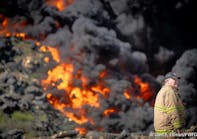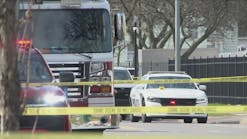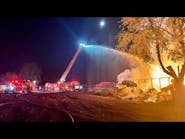WASHINGTON (AP) -- Investigators probing the collapse of the World Trade Center are suggesting that rescuers responding to future emergencies in skyscrapers should not set up command posts in the lobby.
The recommendations from a federal engineering agency are to be released Thursday in New York. People familiar with the work by the National Institute of Standards and Technology spoke Wednesday on condition of anonymity because the report's release was still pending.
The NIST engineers have been examining the emergency response and evacuation of the towers after they were struck by hijacked airliners on Sept. 11, 2001.
The New York City Fire Department set up its command post in the lobbies of the towers, a common practice to quickly monitor the condition of elevators, stairs and sprinkler systems.
Two people involved in the NIST discussions said investigators have decided that such a large-scale command operation would be better placed outside a high-rise to give commanders better protection and a clearer picture of a crisis hundreds of feet above them.
After the attacks, many rescue workers complained that they could have gotten better information about the disaster by watching live television reports.
To better respond to future disasters, high-rises could install equipment that would transmit to nearby fire rescue vehicles critical data about elevators and sprinklers in an emergency.
A cheaper, quicker solution would be to send a smaller team into the lobby to gather such information and relay it back to an outside command center.
On Sept. 11, fire officials set up command posts in the lobbies of both of the World Trade Center towers, and many were crushed when the buildings collapsed. The police department, however, set up its command post outside.
New York fire officials have already begun moving away from the old command post plan used on Sept. 11. After the attacks, the fire department said commanders would have the option of locating the command post in the lobby of a burning building if there was no danger of a building collapse.
The NIST report due Thursday is based on a series of findings issued in April that analyzed the response and the collapse of the buildings. Its findings will be open to public comment for six weeks before the agency issues its final accounting of the collapse, expected in September.
The federal agency, part of the Commerce Department, has also focused on the lack of protection for stairwells and elevators in the event of a major catastrophe. NIST will recommend that large buildings have backup sprinkler systems, and that at least some elevators should have thicker walls so they can continue operating if exposed to water, according to a report in Wednesday's editions of The New York Times.
NIST previously found that office workers left the towers at about half the rate expected, in part due to uncertainty about whether it was more dangerous to stay where they were or start down the many flights of stairs.
The rate of evacuation is important because building designers use those figures in calculating the size, number and accessibility of stairwells.
Congress created the WTC probe three years ago to determine whether the 110-story towers' novel design contributed to their collapse.
Over 10,000 pages of analysis later, the NIST has cleared the fundamental building structure of blame, but taken issue with emergency capabilities.
As the investigation evolved, the engineers' focus turned from the steel bones of the building to the rescue work and some of the smaller internal escape systems, like elevators and stairwells.
''If you didn't look at that, it would be like looking at the sinking of the Titanic and only looking at the hull hitting the iceberg,'' said Glenn Corbett, a professor and fire response expert at John Jay College in New York who has advised the investigation.
Corbett said the investigation shows that the larger a building is, the more backup systems it needs to cope with a major disaster in which everyone must flee immediately.





